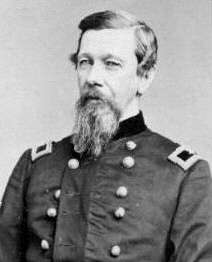Alfred Sully
| Alfred Sully | |
|---|---|
 Brevet Brigadier General Alfred Sully | |
| Born |
May 22, 1820 Philadelphia, Pennsylvania |
| Died |
April 27, 1879 (aged 58) Fort Vancouver, Washington Territory |
| Place of burial | Laurel Hill Cemetery, Philadelphia, Pennsylvania |
| Allegiance | United States of America |
| Service/branch |
United States Army Union Army |
| Years of service | 1841–1879 |
| Rank |
|
| Commands held |
CHRONOLOGICAL COMMANDS Indian War Commands: Seminole War, Florida Mexican-American War Western Indian Campaigns (N. California & S. Oregon) Northern Plains Indian Campaigns (Dakota & Nebraska Territories, Minnesota) Civil War Command: 1st Minnesota Volunteers, Virginia Peninsula Campaign Indian War Commands: North Western Indian Expeditions (Arapaho, Sioux, and Cheyenne) 1867–77 Chaired Investigatory Commissions on Indian Wars Nez Perce War Installation Command Commander, Fort Vancouver |
| Relations |
Son-in-law, Tipi Sapa (Black Lodge), a leader of the Yankton/Nakota band of the Great Sioux Nation Descendant, Vine Deloria, Jr. |
Alfred Sully (May 22, 1820 – April 27, 1879), was a military officer during the American Civil War and during the Indian Wars on the frontier. He was also a noted actor, having acted in the very same play as the one Lincoln went to see shortly before his death.[1]
Biography

Sully was the son of the portrait painter, Thomas Sully, of Pennsylvania.[2] Alfred Sully graduated from West Point in 1841. During and after the American Civil War, Sully served in the Plains States and was widely regarded as an Indian fighter. Sully, like his father, was a watercolorist and oil painter. Between 1849 and 1853, he became chief quartermaster of the U.S. troops at Monterey, California, after California came under American jurisdiction. Then, Sully created a number of watercolor and some oil paintings reflecting the social life of Monterey during that period.
Commands
Sully headed US troops out of Ft. Leavenworth, Kansas, in June 1861 as captain and occupied the city of St Joseph, Missouri, declaring martial law. Violent secessionist uprisings in the city during the early Civil War prompted Sully's occupation.
Sully was commissioned colonel of the 1st Minnesota Volunteer Infantry on February 3, 1862 and served in that rank until promoted to brigadier general on September 26, 1862.
Also during the Civil War years, the Indian Wars continued in the West. General Sully was sent to command cavalry troops and played a repugnant role in the Indian Wars, becoming known as a successful leader. On September 3, 1863, at Whitestone Hill, Dakota Territory, as reprisal for the Dakota Conflict of 1862, his troops destroyed a village of some 500 tipis that lodged Yankton, Dakota, Hunkpapa and Sihasapa Lakota. Warriors, along with women and children, were killed or captured. The troopers' casualties were small.[3]
Marriage
Sully was stationed at Fort Randall, South Dakota during the Minnesota Sioux Uprising, aka the Dakota War of 1862. He met and married a young French-Yankton girl of the Yankton Sioux tribe. She had reminded him of his young Mexican wife, who died of cholera during an epidemic in California. With this marriage, Sully became the son-in-law of Saswe, aka François Deloria (Saswe being the Dakota pronunciation of François), a powerful Yankton medicine man and chief of the "Half-Breed band".
Descendants
Sully's daughter, Mary Sully, was known as Akicita Win (Soldier Woman).[4] She married Rev. Philip Joseph Deloria, an Episcopal priest, aka Tipi Sapa (Black Lodge), a leader of the Yankton/Nakota band of the Sioux Nation.[5] Tipi Sapa is featured as one of the 98 Saints of the Ages at the National Cathedral in Washington, D.C. as the first Dakota Christian minister to his own people.[6] Among their descendants are Yankton Sioux Ella Deloria, an ethnologist, and her nephew Vine Deloria, Jr., a scholar, writer, author of Custer Died for Our Sins, and activist.[7]
References
- ↑ Alfred Sully biography
- ↑ Alfred Sully anecdote
- ↑ Battle of Whitestone Hill (September 3, 1863), North Dakota State Historic Site
- ↑ http://ndstudies.gov/content/alfred-sully
- ↑ Rev. Philip Joseph Deloria mentioned, EpiscopalLife online
- ↑ Litany of Native Saints includes Tipi Sapa's name
- ↑ Biography of Ella Deloria, daughter of Tipi Sapa and granddaughter of François des Lauriers (François Deloria, aka Saswe), University of Indiana
External links
- Pictures of Alfred Sully
- Portrait of Alfred Sully, a Cadet at West Point, 1839, by his father Thomas Sully